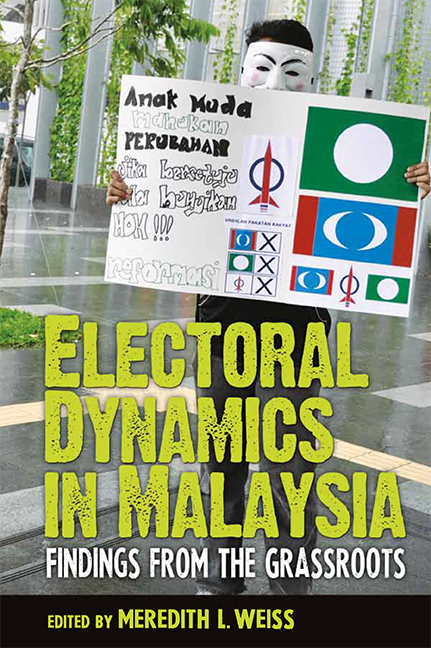Book contents
- Frontmatter
- Contents
- List of Tables
- Foreword
- Acknowledgements
- Glossary & Acronyms
- Chapter 1 Introduction: Patterns and Puzzles in Malaysian Electoral Dynamics
- Chapter 2 Arau, Perlis: The Irresistible Charm of Warlords, Women and Rewards?
- Chapter 3 Padang Serai, Kedah: Between the ‘Personal Touch’ and the Generous Hand
- Chapter 4 Kuala Nerus, Terengganu: New Malay Politics?
- Chapter 5 Balik Pulau, Penang: Home Run for the Home Boys
- Chapter 6 Lumut, Perak: Patronage, Clientelism and the Post-Coup Order
- Chapter 7 Kuantan, Pahang: Revealing the Ordinary
- Chapter 8 Pandan, Selangor: New Electoral Dynamics in Urban Malaysia
- Chapter 9 Kepong and Titiwangsa, Kuala Lumpur: Messages or Money?
- Chapter 10 Rembau, Negeri Sembilan: Personalities and Promises
- Chapter 11 Pulai, Johor: A Tale of Two Coalitions
- Chapter 12 Gelang Patah, Johor: Did Lim Kit Siang Truly Win His Last Gamble?
- Chapter 13 Kota Marudu and Keningau, Sabah: Personality, Patronage and Parochial Politics
- Chapter 14 Tuaran, Sabah: Party Loyalty and Rational Voting
- Chapter 15 Kota Kinabalu, Sabah: BN Loses Its ‘Fixed Deposit’
- Chapter 16 Beaufort, Sabah: Whither Lajim's Popularity?
- Chapter 17 Sibu and Lanang, Sarawak: Defeat of the Bosses
- Contributors
Chapter 2 - Arau, Perlis: The Irresistible Charm of Warlords, Women and Rewards?
Published online by Cambridge University Press: 10 November 2017
- Frontmatter
- Contents
- List of Tables
- Foreword
- Acknowledgements
- Glossary & Acronyms
- Chapter 1 Introduction: Patterns and Puzzles in Malaysian Electoral Dynamics
- Chapter 2 Arau, Perlis: The Irresistible Charm of Warlords, Women and Rewards?
- Chapter 3 Padang Serai, Kedah: Between the ‘Personal Touch’ and the Generous Hand
- Chapter 4 Kuala Nerus, Terengganu: New Malay Politics?
- Chapter 5 Balik Pulau, Penang: Home Run for the Home Boys
- Chapter 6 Lumut, Perak: Patronage, Clientelism and the Post-Coup Order
- Chapter 7 Kuantan, Pahang: Revealing the Ordinary
- Chapter 8 Pandan, Selangor: New Electoral Dynamics in Urban Malaysia
- Chapter 9 Kepong and Titiwangsa, Kuala Lumpur: Messages or Money?
- Chapter 10 Rembau, Negeri Sembilan: Personalities and Promises
- Chapter 11 Pulai, Johor: A Tale of Two Coalitions
- Chapter 12 Gelang Patah, Johor: Did Lim Kit Siang Truly Win His Last Gamble?
- Chapter 13 Kota Marudu and Keningau, Sabah: Personality, Patronage and Parochial Politics
- Chapter 14 Tuaran, Sabah: Party Loyalty and Rational Voting
- Chapter 15 Kota Kinabalu, Sabah: BN Loses Its ‘Fixed Deposit’
- Chapter 16 Beaufort, Sabah: Whither Lajim's Popularity?
- Chapter 17 Sibu and Lanang, Sarawak: Defeat of the Bosses
- Contributors
Summary
Introduction
A royal town and largely rural district not far from the Thai border in tiny Perlis state, Arau attracted unusual attention in this general election. Traditionally a Barisan Nasional (BN) stronghold, the development of four institutions of higher learning – Universiti Teknologi Mara (UiTM), Universiti Malaysia Perlis (UNiMEP), Arau Community College and Polytechnic Tuanku Syed Sirajuddin – as well as Perlis Matriculation College and Arau Technical School has made Arau the education hub of northern Malaysia. Furthermore, the Muda Agricultural Development Authority has designated the district as a prime rice-producing area, especially Tambun Tulang, Simpang Empat and Sanglang (Lembaga Kemajuan Pertanian MUDA 2013).
And yet all was not calm in Arau as elections approached. The ‘warlords’ (powerful division chiefs) in UMNO Perlis had been stirring for some time, their internal rifts plaguing the party. Meanwhile, Pakatan Rakyat (Pakatan) eyed Arau as a possible beachhead in their assault on Perlis. As it developed, the campaign was distinctive, particularly for the three-cornered fights in the parliamentary seat of Arau and state seat of Sanglang, the internal conflicts within UMNO that surfaced here, candidates' efforts to finance their campaigns and the extensive utilisation and involvement of women as canvassers by both the BN and Parti Islam SeMalaysia (PAS). The elections here suggest both the cracks and the power in UMNO's machinery, but also that personalised networks and localised rewards still seem to carry more clout among voters in Arau than do alternative visions of ‘change’.
Progress of the campaign
The background
The rifts in UMNO Perlis surfaced early, as rival groups from Kangar and Arau divisions clashed over the selection of candidates for the 13th general election (GE13). At issue were power struggles among UMNO warlords, mainstays of the BN's patron – client system in Perlis and nationwide. These local chiefs, who represent UMNO's 191 divisions (one for each of the party's parliamentary seats) receive financial allocations from the party and government and lobby for clinics and schools in their districts; in return, they deliver votes (Reme 2013). While Perlis has only three seats and, hence, UMNO divisions, each has a powerful warlord.
- Type
- Chapter
- Information
- Electoral Dynamics in MalaysiaFindings from the Grassroots, pp. 17 - 34Publisher: ISEAS–Yusof Ishak InstitutePrint publication year: 2013

